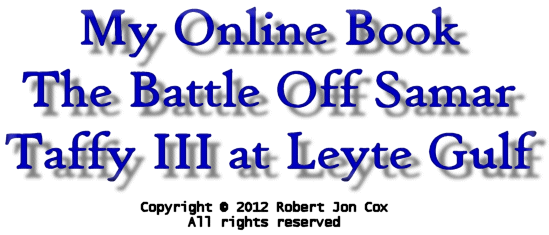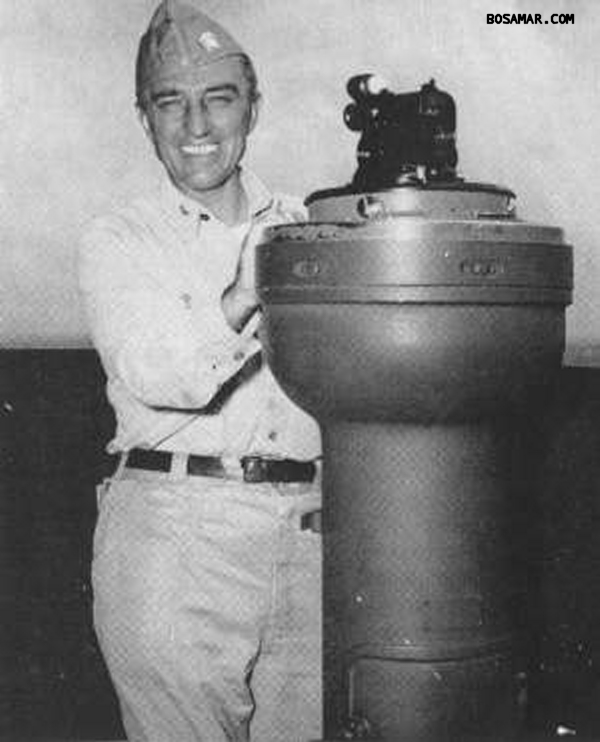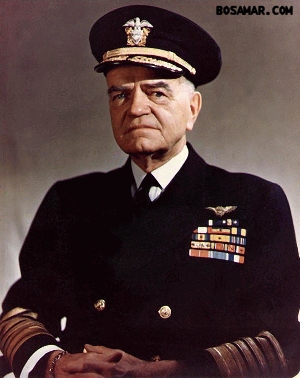
COMMENTS ARE ENABLED ON THE BOTTOM OF THE PAGE
Chapter 2
THE U.S. PACIFIC FLEET
|
The amphibious landings on Leyte were orchestrated by General Douglas MacArthur, Commander of all Pacific Forces and VADM Thomas Kinkaid, Commander Seventh Fleet. They would be the most important of the Pacific war to date. To support this crucial undertaking, the U.S. Pacific Fleet, the most powerful fleet ever assembled, would support the landings with every available ship. Vice Admiral Kinkaid, embarked in his command ship WASATCH, commanded 738 ships at Leyte Gulf. The vast armada included every type of auxiliary, amphibious, and combatant ship in the U.S. inventory, except the large fleet carriers. Guarding the Leyte beachhead were the Northern and Southern Fire Support Units, commanded by Rear Admiral Jesse Oldendorf and RADM G. L. Weyler respectively. Their firepower came from five of the Pearl Harbor battleship veterans: WEST VIRGINIA, TENNESSEE, CALIFORNIA, MARYLAND, PENNSYLVANIA, and MISSISSIPPI. The old battleships of Pearl Harbor were not sent to Leyte Gulf to fight other warships. Indeed, because they were considered nearly obsolete, they were sent to the invasion beach itself to conduct shore bombardment. |
NORTHERN FIRE SUPPORT UNIT RADM George L. Weyler, USN |
|
| Batteships | USS WEST VIRGINIA (BB-48) USS TENNESSEE (BB-43) USS CALIFORNIA (BB-44) |
|
| Destroyers | 6 ships | |
| SOUTHERN FIRE SUPPORT UNIT RADM Jesse B. Oldendorf, USN |
||
| Battleships | USS MARYLAND (BB-46) USS MISSISSIPPI (BB-41) USS PENNSYLVANIA (BB-38) |
|
| Heavy Cruisers | USS LOUISVILLE (CA-28) USS PORTLAND (CA-33) USS MINNEAPOLIS (CA-36) |
|
| Light Cruisers | USS DENVER (CL-58) USS COLUMBIA (CL-56) |
|
| Destroyers | 13 ships | |
Since they were not expected to fight ship-to-ship engagements, only three, WEST VIRGINIA, TENNESSEE, and CALIFORNIA, were fitted with the latest Mark-8 gunnery fire control radar. The remaining three old battleships, MISSISSIPPI, MARYLAND, and PENNSYLVANIA retained the outmoded, inaccurate, Mark-3 gunnery fire control radar.
The remaining Seventh Fleet fighting assets assigned to the Fire Support Units and other support roles were a bit more impressive than the old battleships. They included three heavy cruisers, two light cruisers, and nineteen destroyers, many new. This constituted a formidable fighting force against any opponent. Excluded from this force were the actual amphibious forces of Seventh Fleet that brought the foot soldiers to Leyte. Separated into two landing groups, Northern and Southern, they would disembark the troops from the landing ships, liberty ships, and cargo transports. The landing force also had its own screening ships, consisting of several cruisers and many destroyers.
Embarked on the light cruiser NASHVILLE was General Douglas MacArthur himself. He had kept his promise to the Filipinos, when, thirty-one months earlier he had defiantly stated "...I shall return...." And return he did; seventy to eighty thousand troops landed on the first day of the invasion, October 20.
 |
|
U.S. Navy Photograph "Escort Carrier Group Commander"
Commander Task Group 77.4 |
|
No modern fleet would be complete without air power. Seventh Fleet’s punch came from one of the lesser known vessels assigned to the fleet. They were the CVEs, or escort carriers. These were the smallest of the American carriers that became well known for their extensive use in the Atlantic ocean sinking German U-boats. In the Pacific Fleet, the escort carrier was used for other roles than those available to its big brothers, the large fleet carrier and light carrier. On any given day a CVE pilot might fly Combat Air Patrol, bring water to thirsty army troops, hunt submarines, bomb bridges, perform reconnaissance, or the ship itself be used in an auxiliary role to ferry replacement aircraft to the larger fleet carriers. Such was the life of a CVE pilot, less than glamorous when compared to their brothers on the large fleet carriers. The escort carriers present at Leyte Gulf were headed by Rear Admiral Tommy Sprague, Commander Task Group 77.4. They consisted of eighteen baby flattops, separated into three equal six-ship Task Units, called "Taffies." At Leyte Gulf, the mission of the escort carriers was to provide direct air support for the landings and to put up Combat Air Patrols to protect the invasion fleet. The escort carriers at Leyte Gulf boasted 235 fighters and 143 torpedo planes. Each Taffy had a small screen of three destroyers and four or five destroyer escorts. Most of the men who manned the ships of Task Group 77.4 were reservists who had never seen any major action. One drawback that would rear its ugly head at Leyte was the lack of training received by the escort carrier pilots. Although the CVEs carried some armor-piercing bombs and torpedoes, they were not adequately stocked nor were their pilots adequately trained in warship-attack tactics. Although the CVEs were designated as "aircraft carriers", the term is misleading. They were hardly a match in comparison with the larger light and heavy carriers of the fleet. One-third the size of the heavy carriers, they were cramped, unarmored, thin-hulled vessels, unable to launch and recover aircraft with the ease of the larger carriers. Despite their many restrictions, the escort carriers pulled a heavy load at Leyte Gulf. All three Taffies were stationed east of Leyte Gulf, on a north-south axis. Rear Admiral Tommy Sprague himself commanded Task Unit 77.4.1, known as Taffy I. His task unit operated ninety miles southeast of Suluan Island, near Mindanao. One hundred miles to the north lay RADM Felix Stump’s Task Unit 77.4.2, Taffy II. His group was parallel to the entrance of Leyte Gulf. The northern most group of escort carriers, Task Unit 77.4.3, Taffy III, belonged to RADM Clifton A.F. Sprague. Taffy III sailed thirty to sixty miles off the shore of Samar, the large island northeast of Leyte. |
ESCORT CARRIERS AT LEYTEL GULF Task Group 77.4 RADM Thomas L. Sprague, USN |
|
| Escort Carriers | USS SANGAMON (CVE-26) USS SUWANNEE (CVE-27) USS SANTEE (CVE-29) USS PETROF BAY (CVE-80) USS CHENANGO (CVE-28) USS SAGINAW BAY (CVE-82) |
|
| Destroyers | 3 ships | |
| Destroyer Escorts | 5 ships | |
| Task Unit 77.4.2 (Taffy II) RADM Felix B. Stump, USN |
||
| Escort Carriers | USS NATOMA BAY (CVE-62) USS MARCUS ISLAND (CVE-77) USS MANILA BAY (CVE-61) USS KADASHAN BAY (CVE-76) USS SAVO ISLAND (CVE-78) USS OMMANEY BAY (CVE-79) |
|
| Destroyers | 3 ships | |
| Destroyer Escorts | 5 ships | |
| Task Unit 77.4.3 (Taffy III) RADM Clifton A. F. Sprague, USN |
||
| Escort Carriers | USS FANSHAW BAY (CVE-70) USS ST LO (CVE-63) USS WHITE PLAINS (CVE-66) USS KALININ BAY (CVE-68) USS KITKUN BAY (CVE-71) USS GAMBIER BAY (CVE-73) |
|
| Destroyers | 3 ships | |
| Destroyer Escorts | 4 ships | |
The escort carriers of each Taffy were further organized into a two or four ship section, each commanded by another Rear Admiral.
|
RADM Thomas L. Sprague, USN, Commander Task Group 77.4 Task Unit 77.4.1 (Taffy I) RADM Thomas L. SpragueCOMCARDIV 22 RADM Thomas L. Sprague USS SANGAMON (CVE-26) (Flagship) CAPT M.E. Browder USS SUWANEE (CVE-27) CAPT W.D. Johnson *USS CHENANGO (CVE-28) CAPT G. van Deurs USS SANTEE (CVE-29) CAPT R.E. Blick COMCARDIV 28 RADM George R. Henderson *USS SAGINAW BAY (CVE-82) (Flagship) CAPT F.C. Sutton USS PETROF BAY (CVE-80) CAPT J.L. Kane * = Detached 1645, 24 October 1944 Task Unit 77.4.2 (Taffy II) RADM Felix B. StumpCOMCARDIV 24 RADM Felix B. Stump USS NATOMA BAY (CVE-62) (Flagship) CAPT A.K. Morehouse USS MANILA BAY (CVE-61) CAPT Fitzhugh Lee COMCARDIV 27 RADM William D. Sample USS MARCUS ISLAND (CVE-77) (Flagship) CAPT C.F. Greber USS KADASHAN BAY (CVE-76) CAPT R.N. Hunter USS SAVO ISLAND (CVE-78) CAPT C.E. Ekstrom USS OMMANEY BAY (CVE-79) CAPT H.L. Young Task Unit 77.4.3 (Taffy III) RADM Clifton A.F. SpragueCOMCARDIV 25 RADM Clifton A.F. Sprague USS FANSHAW BAY (CVE-70) (Flagship) CAPT D.P. Johnson USS ST LO (CVE-63) CAPT F.J. McKenna USS WHITE PLAINS (CVE-66) CAPT D.J. Sullivan USS KALININ BAY (CVE-68) CAPT T.B. Williamson COMCARDIV 26 RADM Ralph A. Ofstie USS KITKUN BAY (CVE-71) (Flagship) CAPT J.P. Whitney USS GAMBIER BAY (CVE-73) CAPT W.V.R. Vieweg |
From the beginning the escort carriers were operating on three assumptions:
- That any major enemy force approaching from the north would be intercepted and attacked by the Third Fleet's big carriers and fast battleships.
- That enemy surface units might approach the landing area from the Sulu Sea and Celebes straits, or through San Bernardino Strait.
- That it was most likely that the Japanese would try the "Tokyo Express" runs to reinforce their units in Leyte, or to harry the Americans.
The escort carriers arrived off Leyte Gulf on October 17 and quickly were placed in a high operations tempo to support the amphibious landings.
When the escort carriers arrived at Leyte they were fully loaded with their proper aircraft armament mix of rockets, depth charges, concussion bombs and the like. Each carrier also held about twelve torpedoes and a small amount of semi-armor piercing bombs.
The officers and men who manned the ships in Task Group 77.4 never imagined they would have to directly fight a major fleet engagement on their own. They had become accustomed to their support role and placed their trust in the large carriers and big guns of the U.S. Third Fleet.
Seventh Fleet’s reliance on the large fleet carriers and fast battleships of Third Fleet was unmistakably sound. Guarding VADM Kinkaid’s invasion fleet was ADM William F. Halsey's offensive Third Fleet. He had under his direct command Task Force 38, consisting of four powerful carrier task groups. This was the cream of the American fighting fleet at Leyte Gulf, the armada that would destroy the Japanese fleet if the opportunity presented itself.
Admiral Halsey, as Commander Third Fleet, flew his flag in the new fast battleship NEW JERSEY. It was here he and his staff made the decisions which would direct the course of the battle.
| Admiral Halsey was given two objectives in the Leyte battle plan. First, to: "...cover and support forces of the South-west Pacific Fleet (Seventh Fleet) in order to assist in the seizure and occupation of objectives in the Central Philippines" and to "destroy enemy naval and air forces in or threatening the Philippine area....". One final clause was added to the last objective, giving Admiral Halsey a free hand in whatever he did: "In case opportunity for destruction of major portion of the enemy fleet is offered or can be created, such destruction becomes the primary task." Admiral Halsey believed this last clause was added so he would not hesitate to attack the Japanese if the opportunity offered. Admiral Spruance used extreme caution and failed to press his advantage during the Battle of the Philippine Sea in June 1944. Admiral Spruance was privately criticized by Halsey for not aggressively attacking the Combined Fleet when the opportunity arose. As history had shown, this was the primary difference between the two admirals, each a direct opposite. Offense, not defense, was to be Admiral Halsey's battle cry. The stage was now set for ADM Halsey to use his vast Third Fleet assets. |
 |
|
U.S. Navy Photograph Admiral William F. Halsey, USN |
Vice Admiral Marc Mitscher, Commander of Task Force 38, was embarked in his flagship, the fleet carrier LEXINGTON. It was his responsibility to issue orders to his four task group commanders. However, during the course of the Battle of Leyte Gulf, he was often by-passed by Halsey which led to serious consequences.
The strength of the task groups came from the eight heavy and eight light carriers, which carried 1,178 aircraft. They were supported by VADM Lee's six modern, 16-inch gun, fast battleships, IOWA, NEW JERSEY, MASSACHUSETTS, SOUTH DAKOTA, WASHINGTON, and ALABAMA. The fast battleships were divided into three groups, two each, assigned to Task Groups 38.2, 38.3, and 38.4. All four task groups contained several cruisers and many destroyers.
|
ORGANIZATION OF U.S. THIRD FLEET AT LEYTE GULF ADM William F. Halsey, USN, Commander Third Fleet in NEW JERSEY (BB-62) VADM Marc Mitscher, USN, Commander Task Force 38 in LEXINGTON (CV-16) |
||||
|
Task Group 38.1 |
Task Group 38.2 |
|||
|
Fleet carriers |
USS WASP (CV-18) |
Fleet carriers |
USS ESSEX (CV-9) |
|
| Light carriers |
USS MONTEREY (CVL-26) |
Light carriers | USS PRINCETON (CVL-23) USS LANGLEY (CVL-27) |
|
| Heavy cruisers | USS CHESTER (CA-27) USS PENSACOLA (CA-24) USS SALT LAKE CITY (CA-25) USS BOSTON (CA-69) |
Battleships | USS MASSACHUSETTS (BB-59) USS SOUTH DAKOTA (BB-57) |
|
| Light cruisers | USS SAN DIEGO (CL-53) USS OAKLAND (CL-95) |
Light cruisers | USS SANTA FE (CL-60) USS BIRMINGHAM (CL-62) USS MOBILE (CL-63) USS RENO (CL-96) |
|
| Destroyers | Fourteen ships | Destroyers | Fifteen ships | |
|
Task Group 38.3 |
Task Group 38.4 |
|||
|
Fleet carrier |
USS INTREPID (CV-11) |
Fleet carriers |
USS FRANKLIN (CV-13) |
|
| Light carriers | USS CABOT (CVL-28) USS INDEPENDENCE (CVL-22) |
Light carriers | USS SAN JACINTO (CVL-30) USS BELLEAU WOOD (CVL-24) |
|
| Battleships | USS IOWA (BB-61) USS NEW JERSEY (BB-62) |
Battleships | USS WASHINGTON (BB-56) USS ALABAMA (BB-60) |
|
| Light cruisers | USS BILOXI (CL-80) USS VINCENNES (CL-64) USS MIAMI (CL-89) |
Heavy cruisers | USS WICHITA (CA-45) USS NEW ORLEANS (CA-32) |
|
| Destroyers | Sixteen ships | Destroyers | Twelve ships | |
TG 38.1, commanded by VADM John McCain, was the most powerful task group available, with three heavy and two light carriers. On October 22, due to the non-stop operations conducted by Third Fleet, ADM Halsey sent VADM McCain’s group back to Ulithi for much needed rest and provisions. The decision to send the largest task group away from the Leyte operations area would later prove to be a poor choice when the near-crisis events of the 25th of October occurred.
With the departure of Task Group 38.1 the three remaining task groups, TG 38.2, commanded by RADM Gerald Bogan; TG 38.3, commanded by RADM Frederick Sherman; and TG 38.4, commanded by RADM Ralph Davidson, roamed the waters of the Philippine Sea from the east coast of Luzon to the southern tip of Samar.